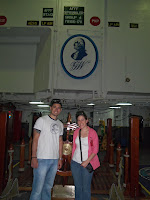Two years ago, with 2 sea bags stuffed with a smorgasbord of
uniforms and gear, I flew half way around the world away from my newly wedded
wife to start my new role as the Ship’s Nurse onboard the only forward deployed
nuclear aircraft carrier (USS GEORGE WASHINGTON CVN-73, aka GW) in the Navy. The first thing you need to know is that I
applied for this position and I am grateful that I was given the opportunity to
experience this aspect of Military nursing (which few nurses will ever
experience in their life). After several
painful hours of traveling around the world, my last leg came to a sudden stop,
literally.
 My first experience as the Ship’s Nurse was landing on the flight
deck in the back of a C-2 Greyhound (see picture at right) going full speed and coming
to a sudden stop in less than 1,092 feet.
Now that may seem like a lot to some people, but I promise you that it
isn’t and I was grateful that I was in the back and couldn’t see a thing. Let’s
recap, in less than 48 hours I flew from San Diego to the GW, which was trying
to out run a typhoon (fun, but extremely exhausted).
My first experience as the Ship’s Nurse was landing on the flight
deck in the back of a C-2 Greyhound (see picture at right) going full speed and coming
to a sudden stop in less than 1,092 feet.
Now that may seem like a lot to some people, but I promise you that it
isn’t and I was grateful that I was in the back and couldn’t see a thing. Let’s
recap, in less than 48 hours I flew from San Diego to the GW, which was trying
to out run a typhoon (fun, but extremely exhausted).  At this point in my military career I had been on only one
other military ship; translation I had no idea what to expect or what I was
getting myself into. This might be a
good opportunity to describe GW a little bit.
An aircraft carrier is truly a modern marvel. The GW is 1,092 feet long, 257 feet wide and
244 feet tall and can carry 6,000 sailors.
It is ultimately a huge floating airport where space is not wasted. There is so much to this ship that even after
2 years I still get lost and discover new areas I didn’t know existed. Fun Fact: the GW is the 17th busiest airport
in the world!
At this point in my military career I had been on only one
other military ship; translation I had no idea what to expect or what I was
getting myself into. This might be a
good opportunity to describe GW a little bit.
An aircraft carrier is truly a modern marvel. The GW is 1,092 feet long, 257 feet wide and
244 feet tall and can carry 6,000 sailors.
It is ultimately a huge floating airport where space is not wasted. There is so much to this ship that even after
2 years I still get lost and discover new areas I didn’t know existed. Fun Fact: the GW is the 17th busiest airport
in the world! What did I do onboard? Medical is not a big department first
off considering we are the only medical facility for 6,000 sailors. Thankfully we care for a fairly young and
healthy population. We do have the
ability to perform emergency surgeries and we do have a 3 bed ICU on top of a 50-bed
ward, as well as other services such as Physical Therapy, Laboratory, and
Psychology just to name a few. When I
did perform patient care, it was mostly for Post Operative recovery. Of course we can’t count out the Medical
Emergencies around the ship.
What did I do onboard? Medical is not a big department first
off considering we are the only medical facility for 6,000 sailors. Thankfully we care for a fairly young and
healthy population. We do have the
ability to perform emergency surgeries and we do have a 3 bed ICU on top of a 50-bed
ward, as well as other services such as Physical Therapy, Laboratory, and
Psychology just to name a few. When I
did perform patient care, it was mostly for Post Operative recovery. Of course we can’t count out the Medical
Emergencies around the ship.
Medical Emergencies ranged from dehydration to falls to physical
injuries. These occurred throughout the
day and night (mostly at night of course), which meant we were on call 24 hours
a day 7 days a week. However, even now I
am surprised at how few physical injuries we saw over the past 2 years
considering there are so many ways for someone to injure themself on a
ship.
 |
| CAPT Lausman (Commanding Officer) |


































